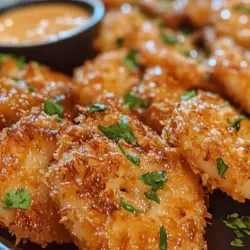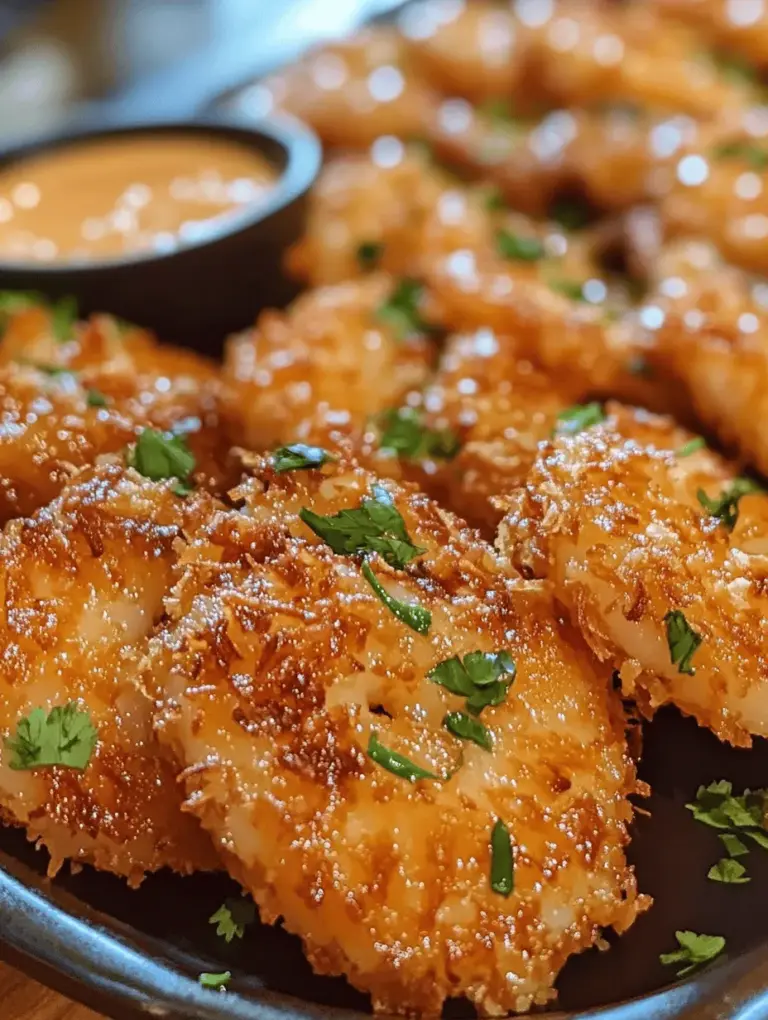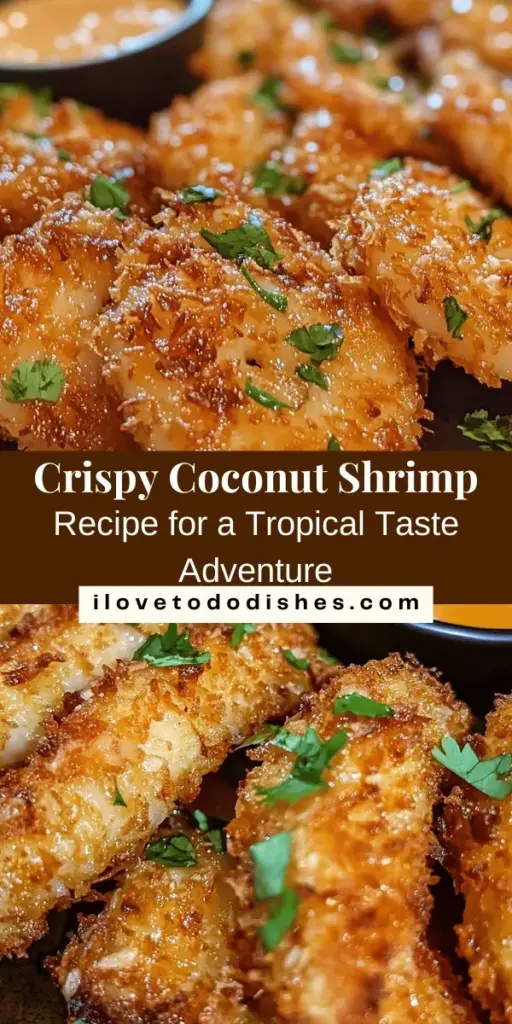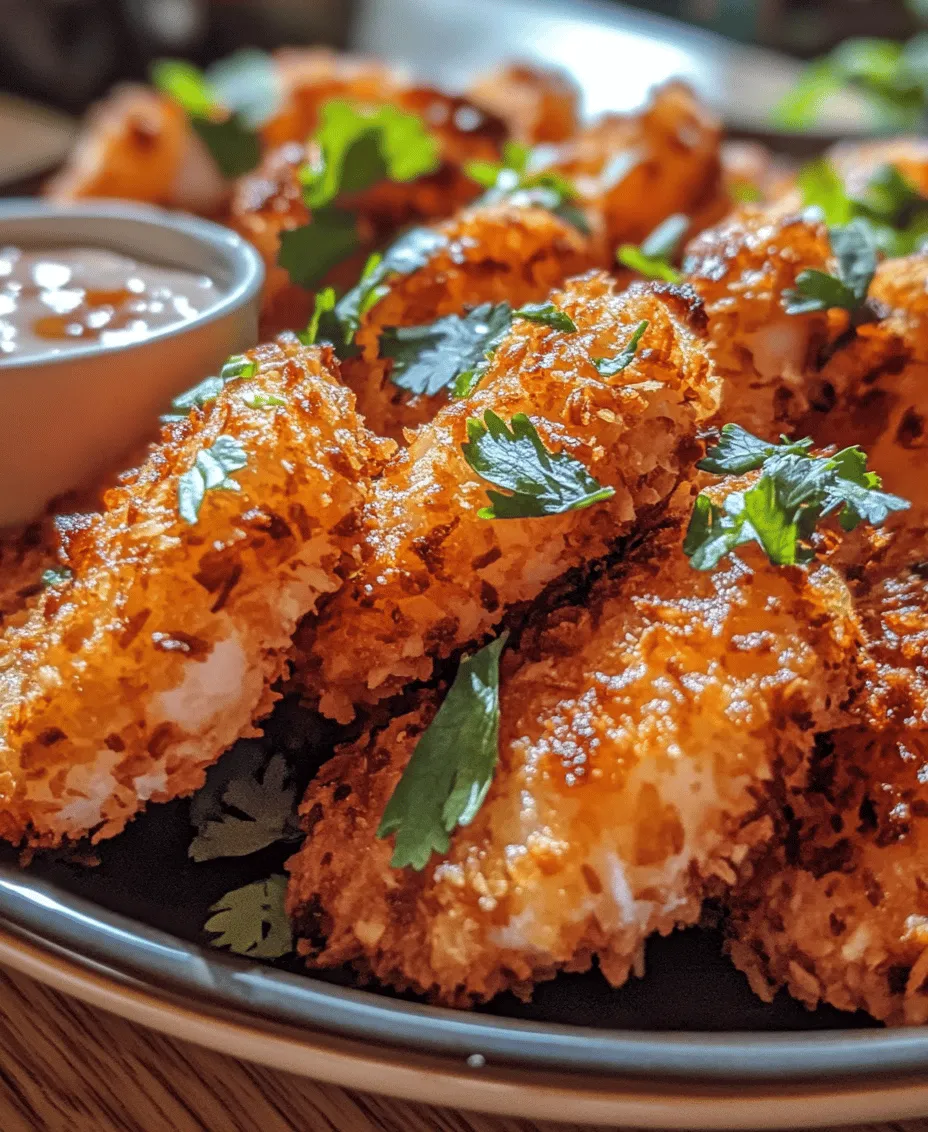Introduction
Crispy coconut shrimp is more than just an appetizer; it’s a delightful culinary experience that transports your taste buds to sun-soaked beaches and tropical paradises. This dish, marked by its enticing crunch and tender shrimp, has earned its place as a beloved favorite in many households and restaurants alike. Imagine sinking your teeth into perfectly fried shrimp, coated in a golden layer of coconut and breadcrumbs, with a hint of tropical sweetness in every bite. It’s no wonder that crispy coconut shrimp has become a staple in festive gatherings, beachside cafes, and family dinners.
What truly sets this dish apart is its harmonious balance of textures and flavors. The crispiness of the outer coating contrasts beautifully with the succulent, juicy shrimp inside, making each bite a delightful adventure. The great news is that you don’t need to travel to a coastal restaurant to enjoy this delicacy. With just a few straightforward steps, you can recreate this restaurant-quality recipe right in your own kitchen. The satisfaction of preparing such a delectable dish at home is unmatched, making it a perfect choice for impressing guests or enjoying a cozy night in.
The Appeal of Coconut Shrimp
Coconut shrimp has roots that stretch across various cultures, particularly in tropical regions where coconut is a staple ingredient. From the Caribbean to Southeast Asia, this dish has evolved, adapting to local tastes and culinary traditions. In many coastal communities, shrimp is abundant, and pairing it with coconut—a fruit that thrives in warm climates—creates a dish that celebrates the bounty of the sea and the richness of the land.
In the Caribbean, coconut shrimp is often served with a spicy dipping sauce, adding an extra layer of flavor that contrasts with the sweetness of the coconut. Similarly, in Asian cuisines, the dish might be accompanied by a sweet-and-sour sauce, showcasing the versatility of the flavors involved. The global popularity of coconut shrimp lies in its ability to evoke a sense of place and culture, making it a favorite among food enthusiasts.
As culinary practices evolve, so does the presentation of coconut shrimp. It can be served as an elegant appetizer at formal gatherings or as a casual snack at beach parties. Regardless of the occasion, the dish continues to draw people in with its allure, making it a must-try for anyone who loves seafood and tropical flavors.
Ingredient Spotlight
To create the perfect crispy coconut shrimp, understanding your ingredients is essential. Each component plays a vital role in delivering that signature flavor and texture that makes this dish so appealing.
Large Shrimp
The star of the show is undoubtedly the shrimp. When selecting shrimp for this recipe, opting for large, high-quality specimens is crucial. Large shrimp not only provide a satisfying bite but also hold up well during the cooking process. Fresh shrimp have a slightly sweet flavor and a firm texture that enhances the overall dish. For the best results, look for shrimp that are sustainably sourced, ensuring that your meal is not only delicious but also ecologically responsible.
Shredded Coconut
Coconut is the defining ingredient in this recipe, providing both flavor and texture. When choosing shredded coconut, you’ll encounter two main varieties: sweetened and unsweetened. Sweetened coconut adds a hint of sweetness, which can complement the natural flavors of the shrimp. However, if you prefer a less sugary profile, unsweetened coconut is the way to go. The choice between the two depends on personal preference, but either way, shredded coconut adds a delightful crunch and a tropical aroma that is simply irresistible.
Panko Breadcrumbs
To achieve that coveted crunch, panko breadcrumbs are the ideal choice. Unlike regular breadcrumbs, panko is coarser and lighter, resulting in a crispier coating when fried. This unique texture allows the breading to adhere beautifully to the shrimp while providing a satisfying crunch that enhances the eating experience. When preparing coconut shrimp, don’t skip the panko; it’s a game-changer in achieving that restaurant-quality finish.
The Dipping Sauce
A great dipping sauce can elevate crispy coconut shrimp to new heights, providing a burst of flavor that complements the dish perfectly. The ideal dipping sauce for this recipe balances sweetness and acidity, with a touch of heat to keep things interesting. A classic choice is a sweet and tangy chili sauce, which enhances the shrimp’s natural flavors while adding a delightful kick. Alternatively, a coconut-based dipping sauce can be created by mixing coconut milk with lime juice and a dash of hot sauce. This combination brings together the dish’s tropical elements, making every bite an explosion of flavor.
Preparation Steps
Now that you understand the allure of crispy coconut shrimp and the essential ingredients, it’s time to dive into the preparation process. Follow these detailed steps to ensure your shrimp turn out perfectly crispy and flavorful.
Rinsing and Drying the Shrimp
Before you begin the breading process, it’s crucial to rinse and dry the shrimp thoroughly. Rinsing helps remove any residual salt or chemicals, enhancing the shrimp’s natural flavor. After rinsing, pat the shrimp dry with paper towels. This step is vital because moisture on the shrimp can prevent the breading from adhering properly, resulting in a less crispy finish. Ensuring your shrimp are dry creates a better surface for the coating to cling to, leading to a more satisfying crunch when cooked.
Setting Up the Breading Station
To achieve a consistent and efficient breading process, set up a three-bowl station. This method simplifies the coating process and prevents the mess that can occur when breading multiple shrimp. Here’s how to arrange your station:
1. Bowl One: Flour – Start with all-purpose flour, seasoned lightly with salt and pepper. The flour helps create a dry surface on the shrimp, allowing the egg wash to adhere better.
2. Bowl Two: Egg Wash – In the second bowl, whisk together eggs with a splash of water. This egg wash acts as glue, holding the breadcrumbs and coconut in place.
3. Bowl Three: Coconut Mixture – Combine panko breadcrumbs and shredded coconut in the third bowl. This mixture will provide the crispy coating that makes the dish so irresistible.
By organizing your ingredients in this manner, you’ll streamline the breading process and ensure that each shrimp is coated evenly.
Breading the Shrimp
Now that your breading station is set up, it’s time to coat the shrimp. This step is straightforward, but a few tips will help ensure the breading adheres properly for that perfect crispy finish.
1. Coat in Flour: Start by dredging each shrimp in the seasoned flour, shaking off any excess. The flour layer creates a barrier that helps the egg wash adhere.
2. Dip in Egg Wash: Next, dip the floured shrimp into the egg wash, allowing any excess to drip off. Make sure each shrimp is fully coated in egg for the best adhesion of the breading.
3. Press into Coconut Mixture: Finally, place the shrimp in the panko and shredded coconut mixture. Press gently to ensure the coating sticks well. This step is crucial; pressing down helps the breading adhere firmly, resulting in a thicker, crunchier crust.
4. Repeat: Continue this process until all the shrimp are breaded, placing them on a plate or baking sheet lined with parchment paper as you work.
By following these preparation steps meticulously, you’ll set the foundation for a delicious and satisfying crispy coconut shrimp dish. Each shrimp will be ready to take on the heat of the frying pan or oven, where they’ll transform into a golden-brown delight.
Cooking Techniques
Once your shrimp are breaded and ready, it’s time to discuss cooking techniques that will ensure they turn out perfectly crispy and flavorful. Whether you choose to fry or bake them, each method has its advantages and can yield delicious results.
Stay tuned for the next part of this article, where we will explore the cooking techniques in detail, providing you with the ultimate guide to achieving crispy coconut shrimp bliss.
Frying Process with a Focus on Technique
When it comes to achieving perfectly crispy coconut shrimp, the frying process is crucial. Here are the essential tips for frying that will elevate your dish from good to sensational.
Choosing the Right Oil
The type of oil you select for frying plays a pivotal role in the final outcome of your coconut shrimp. The best oils for frying are those with high smoke points, allowing you to reach and maintain the high temperatures necessary for proper frying without imparting unwanted flavors. Some excellent choices include:
– Canola Oil: This oil has a neutral flavor and a high smoke point of around 400°F (204°C), making it ideal for frying.
– Vegetable Oil: Another neutral option, vegetable oil is commonly used in frying due to its affordability and high smoke point.
– Peanut Oil: Known for its slightly nutty flavor, peanut oil also has a high smoke point (around 450°F or 232°C), making it a popular choice in Asian cuisine.
Temperature control is vital for optimal crispiness. Aim to heat your oil to a temperature of 350°F (175°C). Using a kitchen thermometer can help you monitor the oil’s temperature accurately. If the oil is too hot, the shrimp may burn before cooking through. Conversely, if it’s too cold, the shrimp will absorb too much oil and become greasy.
Frying in Batches
When frying coconut shrimp, working in batches is essential. Overcrowding the pan can lead to uneven cooking and a soggy texture. Instead, fry the shrimp in small batches, allowing enough space between each piece to ensure even heat distribution. This method also helps maintain the oil temperature, leading to a more consistent crispiness.
As a general rule, fry no more than six to eight shrimp at a time, depending on the size of your frying vessel. Once the shrimp are in the oil, resist the urge to overcrowd or stir them immediately; giving them space allows for even cooking and a golden crust.
Achieving the Perfect Golden Brown
Visual cues are invaluable when determining when your shrimp are ready to be removed from the oil. Ideally, you want to look for a beautiful golden brown color, which typically takes around 2-3 minutes per side. The shrimp will also float to the surface of the oil when they are nearly finished cooking.
To ensure the shrimp are cooked through, you can cut one open to check that it is opaque and no longer translucent. Once they reach that perfect golden brown hue, use a slotted spoon to carefully remove them from the oil and transfer them to a plate lined with paper towels to absorb any excess oil.
Making the Perfect Dipping Sauce
No coconut shrimp is complete without a delicious dipping sauce. Here’s how to create a flavorful sauce that pairs perfectly with your crispy shrimp.
Combining Ingredients
To make a delightful dipping sauce, gather the following ingredients:
– 1/2 cup of mayonnaise
– 2 tablespoons of sweet chili sauce
– 1 tablespoon of freshly squeezed lime juice
– 1 teaspoon of minced garlic
– Salt and pepper to taste
Begin by combining the mayonnaise and sweet chili sauce in a mixing bowl. This combination forms a creamy base with a hint of sweetness. Next, add freshly squeezed lime juice and minced garlic. The lime juice adds a refreshing acidity that balances the richness of the mayonnaise. Mix well until all the ingredients are fully incorporated.
Adjusting Heat Levels
If you prefer a spicier dipping sauce, consider adding a dash of sriracha or your favorite hot sauce to the mix. Start with a small amount, tasting as you go, until you reach your desired heat level. Alternatively, you could add finely chopped jalapeño or a sprinkle of cayenne pepper for an extra kick.
Garnishing and Serving
Presentation matters, especially when serving to guests. Consider garnishing your dipping sauce with freshly chopped cilantro or a slice of lime. This not only adds a pop of color but also enhances the overall flavor profile. Serve the sauce in a small bowl alongside the crispy coconut shrimp, allowing everyone to enjoy a dip of their choice.
Serving Suggestions
When it comes to serving coconut shrimp, creativity can enhance the overall dining experience. Here are some ideas to present your dish beautifully.
Plating Ideas
For an elegant presentation, consider using a large white serving platter. Arrange the crispy coconut shrimp in a circular pattern, leaving space in the center for the dipping sauce. Decorate the platter with lime wedges and sprigs of cilantro for added color and freshness.
Alternatively, for a casual gathering, you can serve the shrimp in a basket lined with parchment paper. This rustic approach makes for a fun and inviting serving style that encourages sharing.
Pairing Suggestions
Coconut shrimp pairs beautifully with various side dishes and drinks. Consider serving them alongside:
– Tropical Fruit Salad: A refreshing mix of pineapple, mango, and papaya complements the shrimp’s flavors and adds a vibrant touch.
– Coconut Rice: The subtle coconut flavor in the rice enhances the overall theme of the dish, creating a cohesive meal.
– Coleslaw: A crunchy slaw with a tangy dressing provides a delightful contrast to the crispy shrimp.
For beverages, a chilled glass of white wine, such as Sauvignon Blanc or a light lager, works well. If you prefer non-alcoholic options, consider serving coconut water or a fruity mocktail to keep the tropical vibe alive.
Nutritional Information
Coconut shrimp can be a delicious treat, but it’s also essential to be mindful of its nutritional aspects. The key ingredients contribute to both flavor and nutritional value.
A typical serving of coconut shrimp (about 4-5 shrimp) contains approximately:
– Calories: 250-300
– Protein: 15g
– Fat: 15g (mostly from the coconut and frying oil)
– Carbohydrates: 25g
While coconut shrimp can be enjoyed as an indulgence, it also offers protein from the shrimp and healthy fats from the coconut. To make this dish healthier, consider baking or air frying the shrimp instead of deep-frying, which significantly reduces the oil content.
Conclusion
Crispy coconut shrimp is a versatile dish that shines in both casual and formal settings. From mastering the frying technique to crafting the perfect dipping sauce, each step enhances the overall experience. Its delightful crunch, paired with the sweet and tangy sauce, makes it a crowd-pleaser at any gathering.
Whether you’re hosting a tropical-themed party or looking for a fun appetizer for game night, this recipe is sure to impress. So gather your ingredients, follow the steps carefully, and embrace the joy of cooking at home. With these tips and techniques, you’ll achieve coconut shrimp bliss that delights the senses and brings a taste of the tropics to your table.



